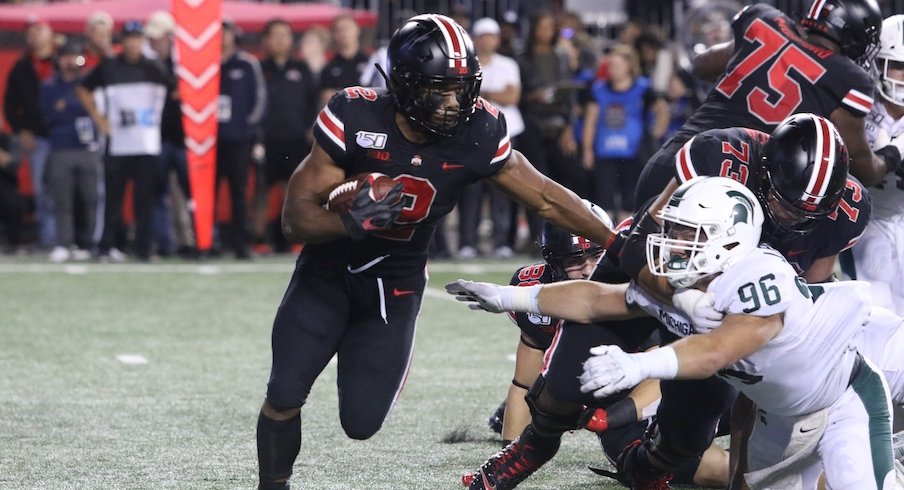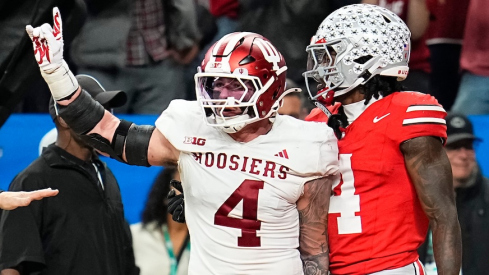The first quarter of Ohio State’s 34-10 win against Michigan State on Saturday looked familiar, but it wasn’t reminiscent of anything that had happened the prior five weeks.
Rather, it felt like Mark Dantonio might have brought the same voodoo he used to upset the Buckeyes in 2013 and 2015 to Ohio Stadium.
“It was a typical Ohio State-Michigan State game in the beginning,” J.K. Dobbins said after the win. “Those guys, they've got a good defense. I think they were the No. 1 rushing defense in the nation.”
Almost.
The Spartans entered Saturday with the second-best run defense in the nation, allowing just 1.86 yards per carry in their first five games of the season. In the first quarter on Saturday, Michigan State actually improved on its average, holding Ohio State without a single yard on the ground on 10 carries. After five games of the Buckeyes’ offensive line imposing its will on defensive fronts, the unit struggled to get any kind of an early push.
Joshua Alabi struggled enough at right tackle on the first two series that he got replaced by Branden Bowen, who returned to action from a back injury. Bowen then proceeded to play what he described as the “worst game” he has ever played. Thayer Munford had an injury scare at the end of the first quarter, but he returned to the game a possession after falling to the ground and needing a trainer to help him walk to the sideline.
“Now, he's running hard. He's putting his foot in the ground. He's finishing runs. He's running violently. He's very definitive in the decisions that he's making in the run game.”– Tony Alford on J.K. Dobbins
Michigan State both being what Bowen called the “hardest-playing team” Ohio State has faced and tossing a few confusing looks at the offensive line exacerbated the early issues moving the ball on the ground.
“I think it was just getting those first few series in, figuring out the defense, really getting the feel for how they were going to play the whole game because they came in and played a little bit different than what we thought,” Bowen said. “Took us off double teams. We excel in double teams. That's why we kind of struggled a little bit trying to figure all that out. After we got it all figured out, we kind of took off.”
By the middle of the second quarter, Ohio State’s offense had found its rhythm. And Michigan State’s defense had lost the mojo found in a Dantonio team primed for an upset.
The true game-breaking run that set the remainder of the game in motion came on a 67-yard touchdown from Dobbins. The junior running back followed center Josh Myers to the second level on a perfectly blocked play then shot past the rest of the Michigan State defense. Cornerback Josiah Scott took a diving swing to try to knock the ball out, but Dobbins didn’t slow down, housing the second-longest run of his career.
On the scoreboard, that gave the Buckeyes a 24-10 lead. In the flow of the game, Ryan Day viewed it as much more.
“I mean that was a home run hit right there that I think really changed the game,” Day said. “But up to that point we started to get it going a little bit but that kind of shifted and turned it into I think almost a 300-yard quarter. And anytime you can hit home runs like that in the run game, boy, it's a huge one. But it's one thing to go a 20-yard gain, but to come off the back end, and that was 60-something yards, 67 yards, that's a game-changer.”
Prior to Saturday, Michigan State hadn’t allowed a single run for 30 yards, let alone more than double that.
The Spartans also had only allowed more than 100 rushing yards in one game, and they hadn’t given up more than 139 rushing yards in a game yet. Dobbins, by himself, broke that mark with 172 yards and a touchdown coming on 24 carries. Combined with Master Teague (14 carries, 90 yards) and Fields (11 carries, 61 yards), the Buckeyes more than doubled Michigan State’s record of rushing yards given up by tallying 323 yards on the ground.
“It's very hard to run the ball against them,” Day said. “And you've got to wear them down. You have to wear them down. And you've got to cover them up. The running backs have to turn four-yard runs into six. And then eventually over time, if you can start to run on them, you can maybe start to crack some. And that's kind of what happened. But the key to that is some of those play-action passes. Those kind of got us going a bit.”
The ground game has gotten Ohio State going more than just “a bit” this season.
In all games but the victory against Miami (Ohio), the Buckeyes have totaled more rushing yards than passing yards. Dobbins, who characterized his 2018 performance as a “failure,” has looked completely refreshed in the past couple games – even though he says he has “a lot more potential to reach.” He has rushed for at least 170 yards in each of the Buckeyes' first three Big Ten games this season.
“I think that's a combination of a lot of things, not just (Dobbins),” running backs coach Tony Alford said. “It's the offensive line, guys blocking downfield. Now, he's running hard. He's putting his foot in the ground. He's finishing runs. He's running violently. He's very definitive in the decisions that he's making in the run game.”
This team wants to run the ball, and it has now shown it can do so with consistency.
The first quarter might not have felt like the same rushing offense that led the Buckeyes to blowout wins in the first five games. But the final three quarters of Dobbins, Teague and Fields gashing one of the nation's top run defenses did.


